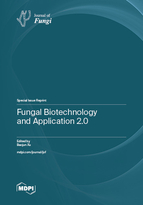Fungal Biotechnology and Application 2.0
A special issue of Journal of Fungi (ISSN 2309-608X). This special issue belongs to the section "Fungi in Agriculture and Biotechnology".
Deadline for manuscript submissions: closed (29 February 2024) | Viewed by 15699
Special Issue Editor
Interests: food science; phytochemicals; nutraceuticals; pharmaceuticals; functional foods; molecular nutrition; cell biology
Special Issues, Collections and Topics in MDPI journals
Special Issue Information
Dear Colleagues,
This Special Issue (SI) calls for submissions of either original studies or literature reviews that describe the biotechnology and advanced applications of fungi which are beneficial or harmful to human beings. This SI will collect recent original research findings and critical reviews on current fungal biotechnology and the industrial application of fungi in the fields of cosmetics, food and pharmaceuticals. The topics of interest include but are not limited to:
- The application of fungi in all kinds of industries (e.g., scientific research, fermentation for cosmetic ingredients and pharmaceuticals, and food);
- Fungal secondary metabolites and metabolic flow analysis;
- Bioprospecting of novel fungi from specific environments;
- Mechanisms of pathogenic fungal infection and its prevention and treatment;
- Ecology, morphological and ultrastructural diversity of fungi;
- Cultivation and utilization of medicinal or edible mushrooms.
Prof. Dr. Baojun Xu
Guest Editor
Manuscript Submission Information
Manuscripts should be submitted online at www.mdpi.com by registering and logging in to this website. Once you are registered, click here to go to the submission form. Manuscripts can be submitted until the deadline. All submissions that pass pre-check are peer-reviewed. Accepted papers will be published continuously in the journal (as soon as accepted) and will be listed together on the special issue website. Research articles, review articles as well as short communications are invited. For planned papers, a title and short abstract (about 100 words) can be sent to the Editorial Office for announcement on this website.
Submitted manuscripts should not have been published previously, nor be under consideration for publication elsewhere (except conference proceedings papers). All manuscripts are thoroughly refereed through a single-blind peer-review process. A guide for authors and other relevant information for submission of manuscripts is available on the Instructions for Authors page. Journal of Fungi is an international peer-reviewed open access monthly journal published by MDPI.
Please visit the Instructions for Authors page before submitting a manuscript. The Article Processing Charge (APC) for publication in this open access journal is 2600 CHF (Swiss Francs). Submitted papers should be well formatted and use good English. Authors may use MDPI's English editing service prior to publication or during author revisions.
Keywords
- biotechnology
- utilization
- health benefits
- secondary metabolites
- fermentation
- mushroom
- practical applications







